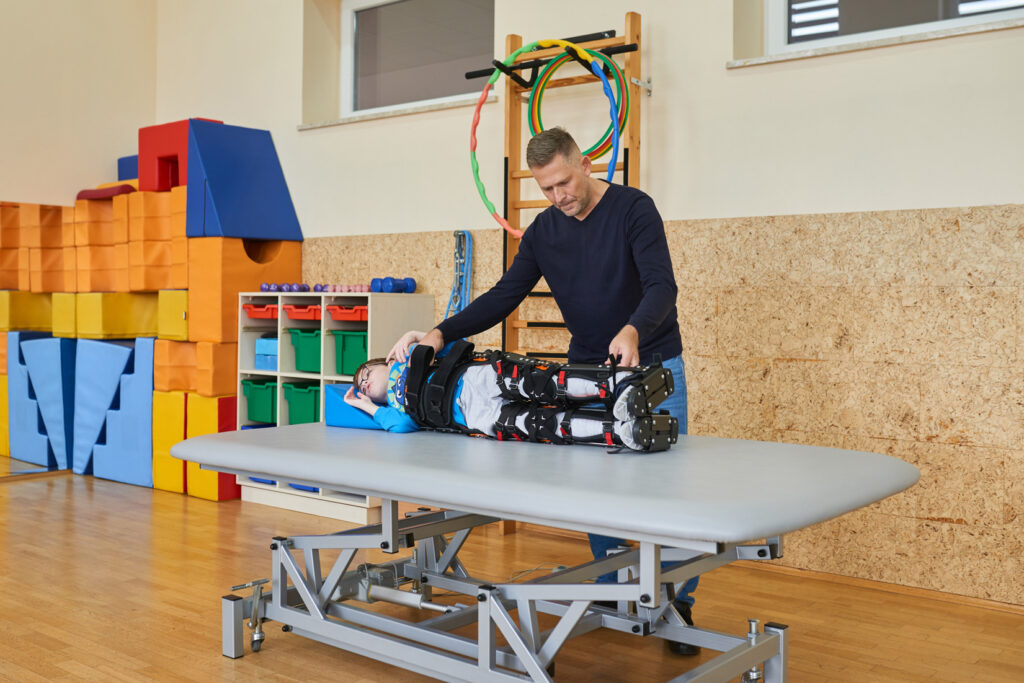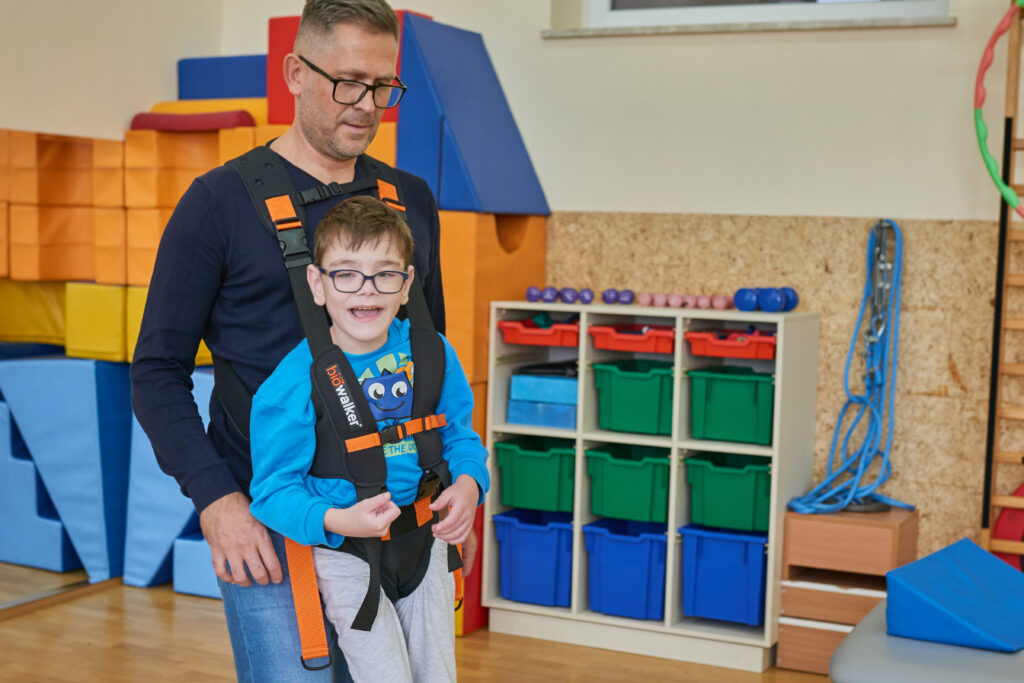
Hubert
Hubert is a 10-year-old boy with cerebral palsy and spastic paresis of the lower limbs. The boy is wheelchair-bound, has a positive attitude to the environment and is very cheerful. He attends a Special School and Education Center where he participates in rehabilitation classes. His spontaneous activity is limited, he can independently change from a wheelchair, crawl on all fours and walk with the assistance of a therapist. The boy has considerable difficulties in self-service activities, he signals physiological needs. His dream is to play soccer. He is often in a sitting position, which causes contractures in the joints of the lower limbs.
GOAL
The main goal of Hubert’s therapy was to re-educate the gait pattern, stabilization and balance, and to reach a vertical position preventing lower limb contractures, which would enable the child to realize, at least partially, his dream of playing football.
METHOD
The boy underwent a proprietary rehabilitation program with the use of a pediatric hip-knee-ankle-foot orthosis (HKAFO) aimed at improving gait, stabilization and balance, and adopting a vertical position preventing lower limb contractures. The therapy was conducted for 3 months and included: gait training with the use of the HKAFO orthosis and individual exercises with a therapist aimed at relaxing the muscles: quadriceps, hamstrings and iliopsoas, and increasing the range of motion in the joints. In addition, exercises strengthening the muscles of the trunk and lower limbs were used.
The following were used to assess the effects of rehabilitation: 1) analysis of the gait pattern in the sagittal and frontal planes using the Observational Gait Scale 2) assessment of gait speed and efficiency using the distance test and a 2-minute walk test 3) assessment of static balance using the Romberg test and the balance scale Berg 3) assessment of dynamic balance using the timed up and go test 4) assessment of muscle contractures using the Thomas test, the Duncan test and the finger-to-floor test. The boy was assessed twice: the first examination was carried out before the start of the rehabilitation program, the second examination immediately after its completion. The evaluation was carried out under the same conditions using the same measurement tools.
RESULTS
In the analysis of the gait pattern, a quantitative assessment of disturbances was made, taking into account, among others: knee position in the Mid Stance phase, foot contact with the ground in the Initial Contact phase and in the Mid Stance phase, heel lift time, hindfoot position in the Mid Stance phase or the support plane. Both lower limbs were assessed. A significant difference in the results obtained between the first and second study was demonstrated. After rehabilitation with the pediatric orthosis HKAFO, an improvement was noted in all gait parameters analyzed in the Observational Gait Scale. In addition, assessing the quality of gait, an improvement in stride length and better foot load was noted. In terms of gait velocity analysis, an increase from 0.6 m/s in the first study to 0.8 m/s in the second study was noted. Similarly, after rehabilitation, there was an improvement in walking capacity, reflected in an increase in walking distance of 4 meters over a distance of 20 meters. Analyzing the results of the boy’s statistical balance, it was shown that before the start of rehabilitation on the Berg scale, the patient scored 8 points, after three months of rehabilitation, an improvement of 1 point was noted, similarly, in the Romberg test, an improvement of 4 seconds was noted. However, in terms of dynamic balance in the timed up and go test before rehabilitation, the result was 25 seconds, and after the therapy 19 seconds. After rehabilitation with the use of the pediatric orthosis HKAFO, a positive change in the contractures of the muscles of the lower limbs was also observed, achieving partial relaxation in the flexors of the knee and hip joints. The HKAFO orthosis allows people who do not walk independently or are disturbed to move around. The product protect the patient’s legs and enable movement in the correct ranges, making the training more effective and indirectly affecting the neuroplasticity of the central nervous system. Orthopedic equipment also protects against the development of pathological compensations. During the therapy, the patient moved in the correct movement patterns, symmetrically loaded the lower limbs and was in an upright position, which resulted in greater motivation and made the therapy more attractive. With the help of HKAFO, Hubert was able to play football, overcome an obstacle course, walk on uneven ground and go up and down stairs, which caused joy and made classes more attractive, while positively affecting the mental sphere of the child.
CONCLUSIONS
Rehabilitation with the use of the HKAFO orthosis resulted in an improvement in balance, stabilization and gait quality. On the basis of the analyzed case, it can be concluded that through a program of therapy appropriately adapted to the patient, the orthosis can improve the quality of life and protect against the occurrence of secondary neurological symptoms. Patients with cerebral palsy in the course of this disease are affected by disorders at the structural level that affect the function of the musculoskeletal system. The main goal of effective therapeutic action is the use of lower limb orthoses that ensure proper function, correction and improvement of life comfort. The purpose of using orthoses is to change the incorrect vertical position of the ground reaction force vector, so that in a given phase of gait the external moment of force acts in a manner similar to the conditions of physiological gait. At the same time, working muscles generate internal torque. An interdisciplinary approach and adjustment of orthoses to the changing condition of a patient with cerebral palsy is the key to the effective use of orthopedic supplies for the lower limbs.
In addition, staying in an upright position indirectly affects individual systems: circulatory, respiratory, muscular and bone, which results in restoring or helping to achieve optimal patient fitness. Numerous studies report the need to use orthoses in children with cerebral palsy. Orthoses help to extend the knee joints by using the reaction forces from the ground. Children with cerebral palsy experience functional limitations due to excessive muscle weakness, spasticity and impaired motor control, and various types of orthoses are often recommended to help them function during the day.
Based on the analyzed case, it can be concluded that the pediatric orthosis HKAFO is an easy-to-use tool that brings positive effects in terms of gait re-education, stabilization and balance, and can be recommended for use in everyday clinical practice.
Doctor of Health Sciences (DHSc)
Andżelina Wolan-Nieroda
















